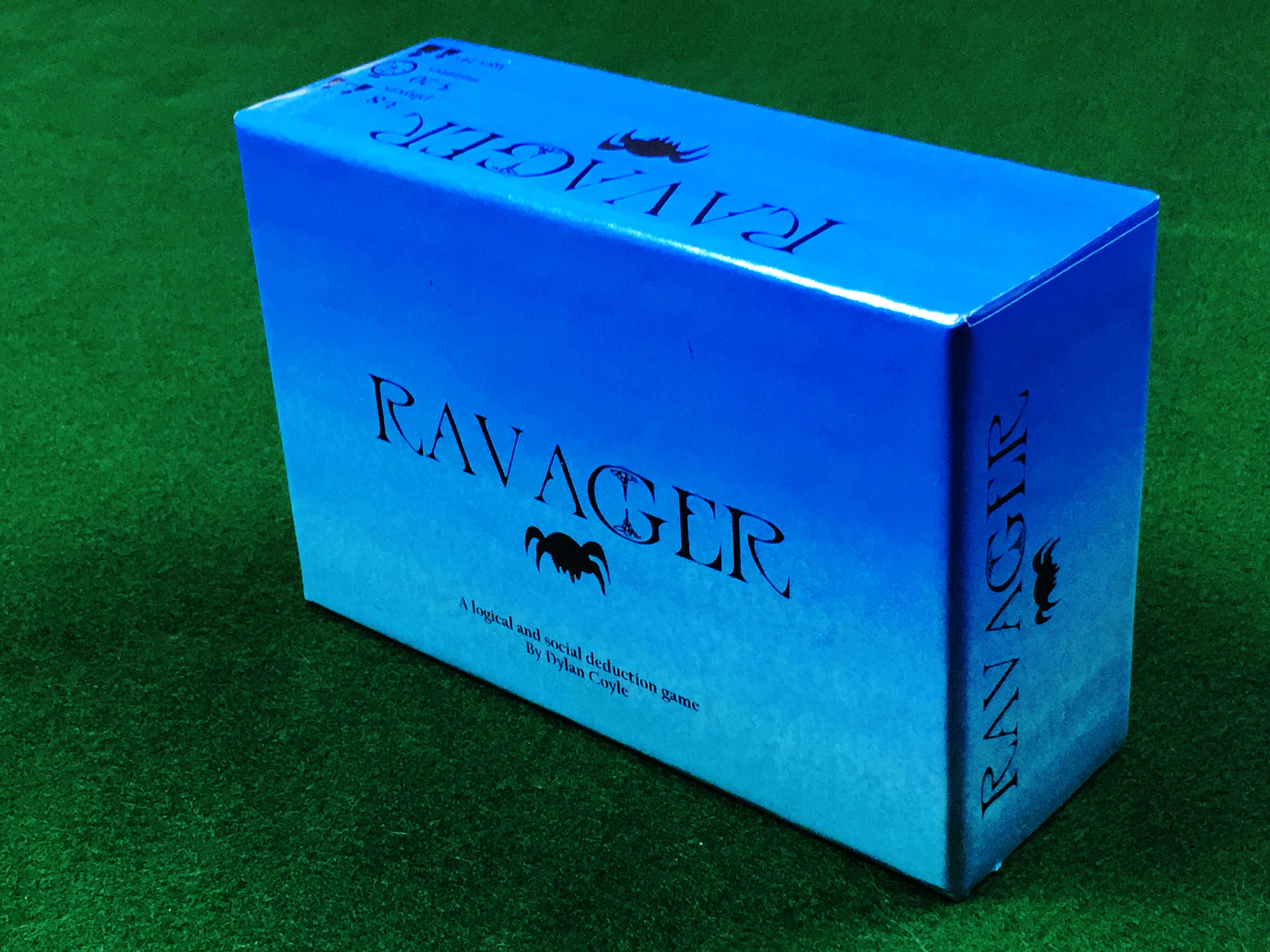
Ravager is a game by Dylan Coyle that puts players in the role of a crew of distrustful pirates seeking the treasure described in the journal of their recently deceased captain.
The game has a set of island cards with 8 different options for 8 different island features such as landscape, tree varieties, structures, land monsters, sky monsters, etc. To set up the game, players draw one random card from each set of features and place them all in the treasure box without looking at them, dealing out the rest of the feature cards evenly to all players. The only safe island (i.e. the island where the treasure is hidden) is the one that matches all features in the treasure box.
After this, players get a secret role of either Explorer or Ravager. The Explorers wan to identify either the island with treasure or the identity of a Ravager, and the Ravagers want at least one Explorer to choose to visit a dangerous island (i.e. any island other than the one with the treasure).
Players have 15 minutes to take turns selecting islands and asking to see a card from another player’s hand as proof that it is not the island with the treasure. Players may also choose to call for a vote on which island to visit — or which player is a Ravager that must walk the plank.
This is one in a series of seven articles outlining my judging decisions for the finalists in The Game Crafter‘s social deduction game design challenge. You can see the full article list here.
Visit Gamified Content’s YouTube channel to watch my review of Ravager’s shop page from the semi-finalist judging round.
High-Level Review
This was the only entry I saw in the entire contest that hit on the bonus point for using a story-based set of instructions to teach the game. The pirate treasure hunt theme was captivating, and I loved the mix of psychological thriller and macabre humor mixed together in the narrative.
The mechanic used for creating the deductive puzzle was ambitious and, unfortunately, ended up having some major mathematical errors. The version entered into the contest had a 1 in 262,144 chance of creating a solution that was represented on one of the island cards in the game. In other words, it was highly unlikely for the Explorers to win in any other way than correctly identifying a Ravager.
From talking with the designer after the fact, I know this was not the intention. I believe re-working the elements included on each island card plus a tweak to the treasure box setup step can correct the issue while keeping the puzzle challenging for the Explorers.
The win conditions for each role were a bit difficult to follow. It seems likely they could be simplified to make them easier to learn and remember.
The timed play was helpful for avoiding the analysis paralysis this game could easily fall victim to without a timer.
Components
The game comes in a small stout box and has a clean simple cover design. The side of the box includes game stats like player count and game time.
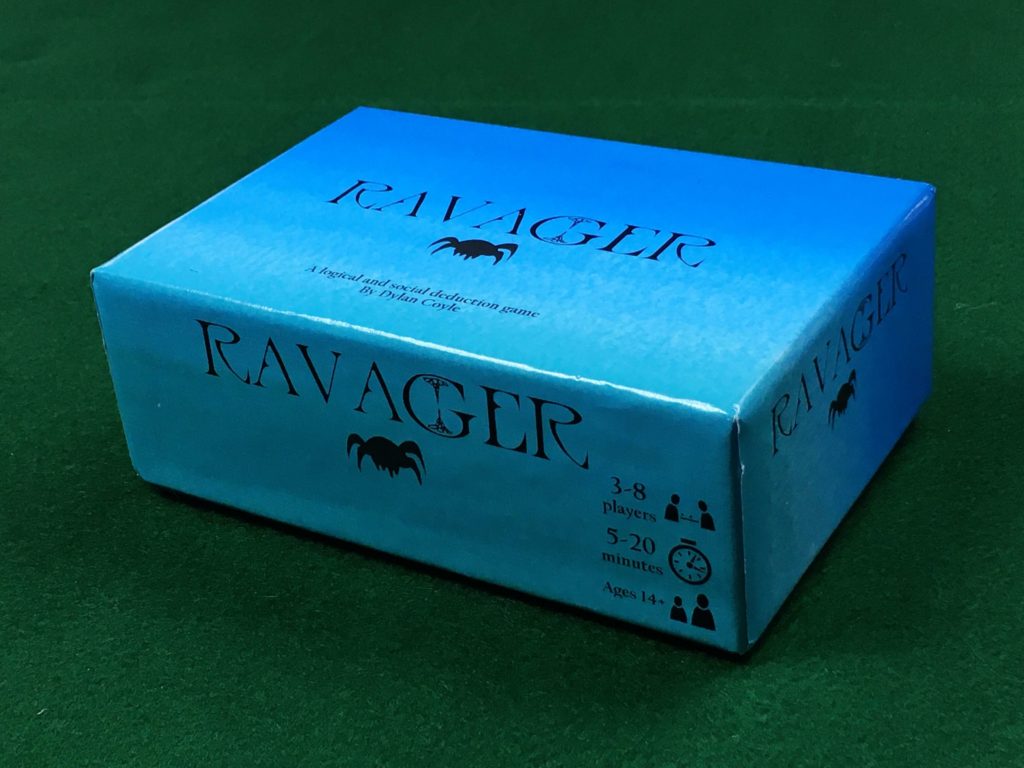
The back of the box is blank. If this is only sold online, no one will look at the back of the box when making a purchasing decision, so it might not matter that much if it never has a game play description or diagram added to the back cover.
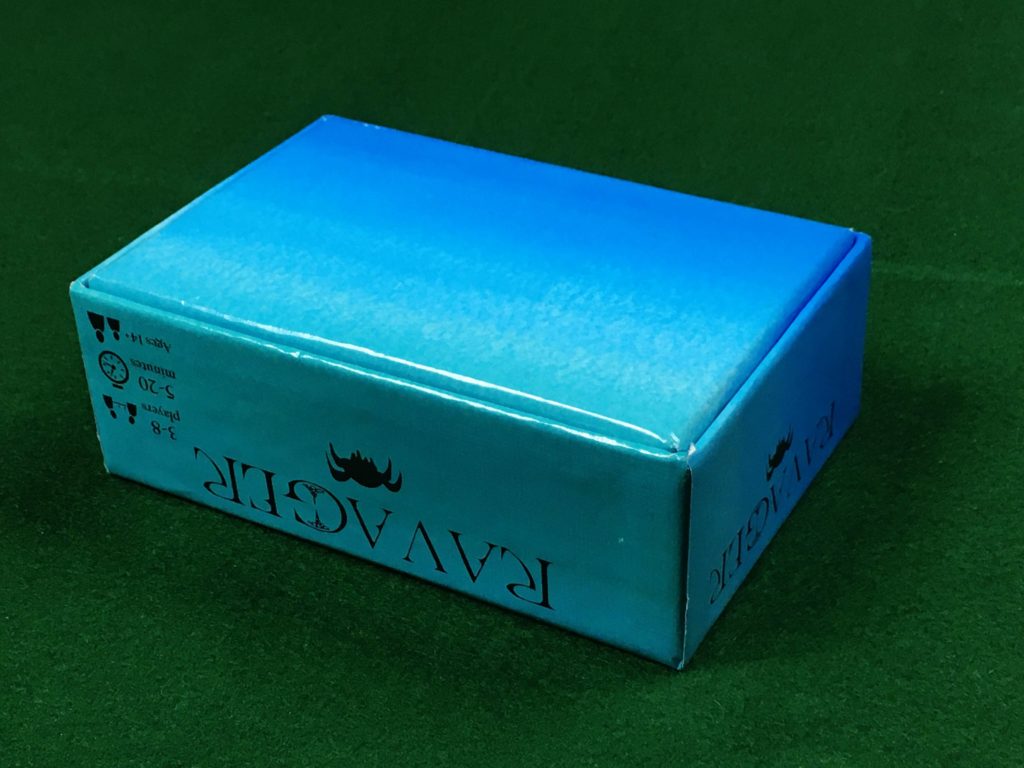
This box was packed so full that I actually wasn’t able to get all the components back in the box after I took them out the first time. The main thing I could never fit back inside was the electronic timer, which was easy for me to give up knowing I should always be able to use the timer on my phone.
The rest of the parts do fit, but they still require careful stacking.
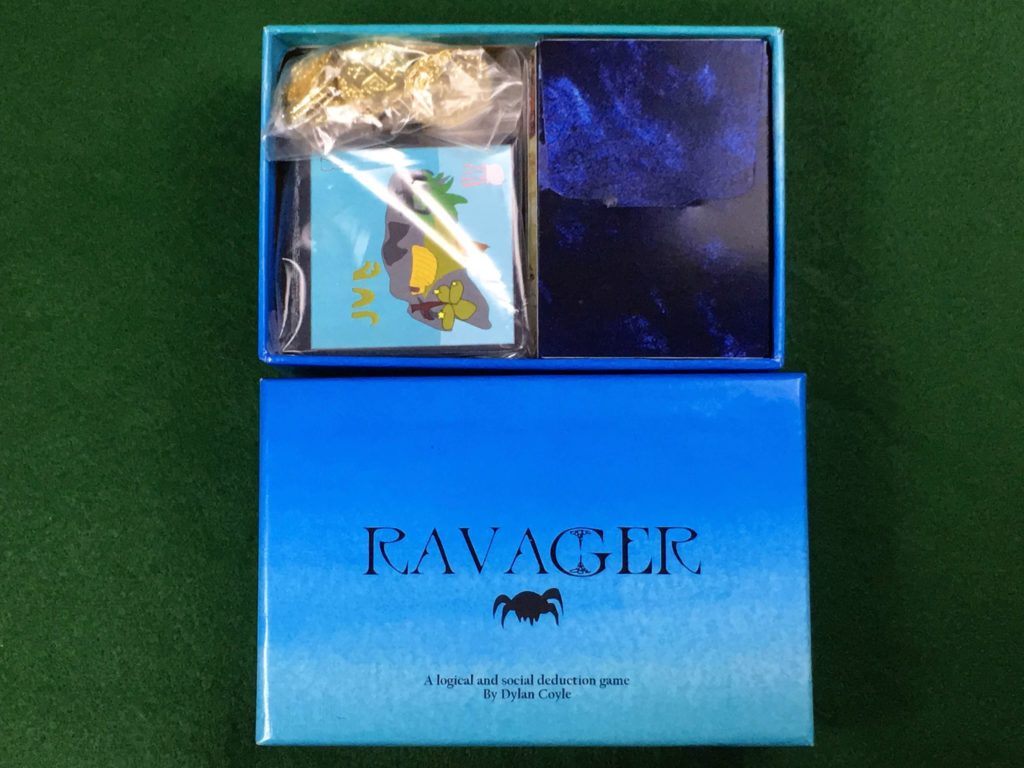
The components in this game are really fun and thematic.
The treasure box where all of the secret cards are kept is an 18 card hook box that also doubles well as a place to store the role and voting cards when putting the game away.
The cards with island features are “pages from the captain’s journal” and each have a short descriptive sentence about the captain’s experience visiting an island with that feature.
There’s a big stack of island cards each with a unique mix of island features. The illustrations are very rudimentary, but, for me at least, this somehow adds to the charm.
The deduction sheets are UV coated mats that work with dry erase markers. My box included 9 markers for a game that only goes up to 8 players, so I even have an extra in case one of them dries out.
There is also a velvet bag and some hefty metal doubloons. These are only used in the event you play multiple games and need to keep track of each player’s wins across several plays.
The rules sheet had some good diagrams and fun thematic graphic design. The parchment background is nice, and the font choice is easy to read.
As a minor aside about TGC component options, I will say that I personally would prefer a booklet over a document for the rule book. Folding and unfolding the document to reference the rules started to crack the printing fairly quickly. Although the rules remain legible, they look more worn out than it seems like they should after only one play. (If the document background was white and the text was placed away from the crease locations, this would be less apparent, but it would also take away from the fun pirate theme.)

Each island card has a unique mix of the different island features. They all have a number in the bottom corner players use to vote on the island they believe is safe. The text for the numbers would be easier to read if it were a heaver typeface. As-is, the numbers are a bit thin and faint.
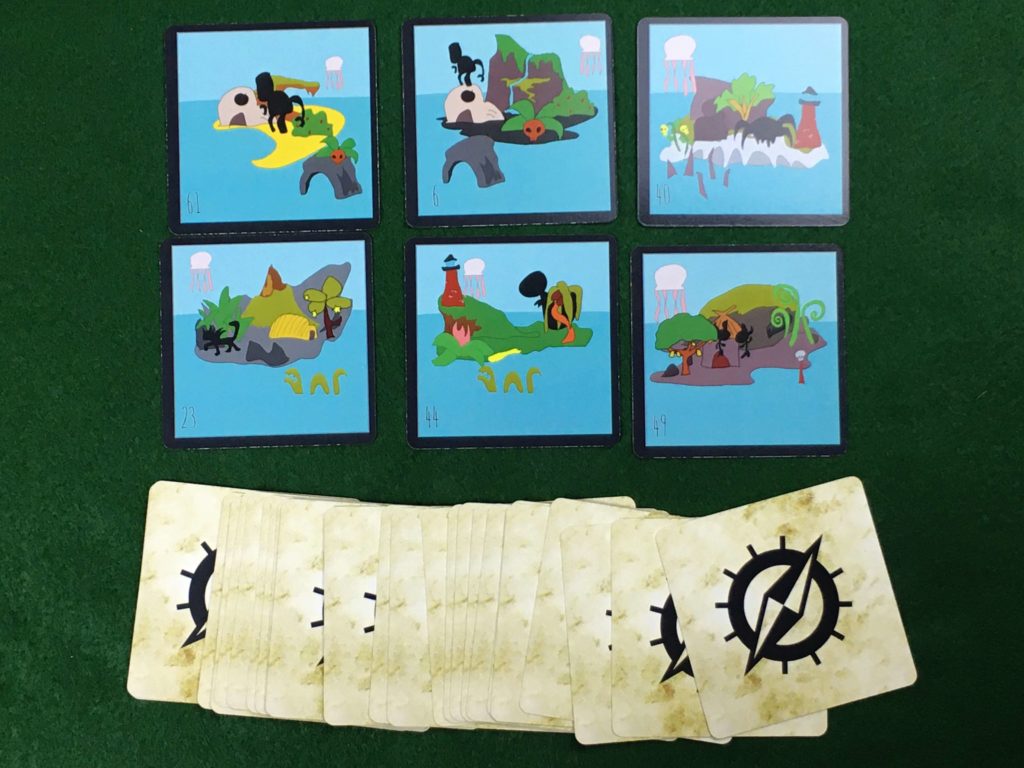
Every island card in the box matches with a set of 8 captain’s journal cards, but there are 16,777,152 sets of 8 captain’s journal cards that do not have a matching island card.
This happened as a result of a miscalculation where the designer thought 8 options for 8 features would make 64 (8×8) possibilities, but it instead creates 16,777,216 (8^8) possibilities.
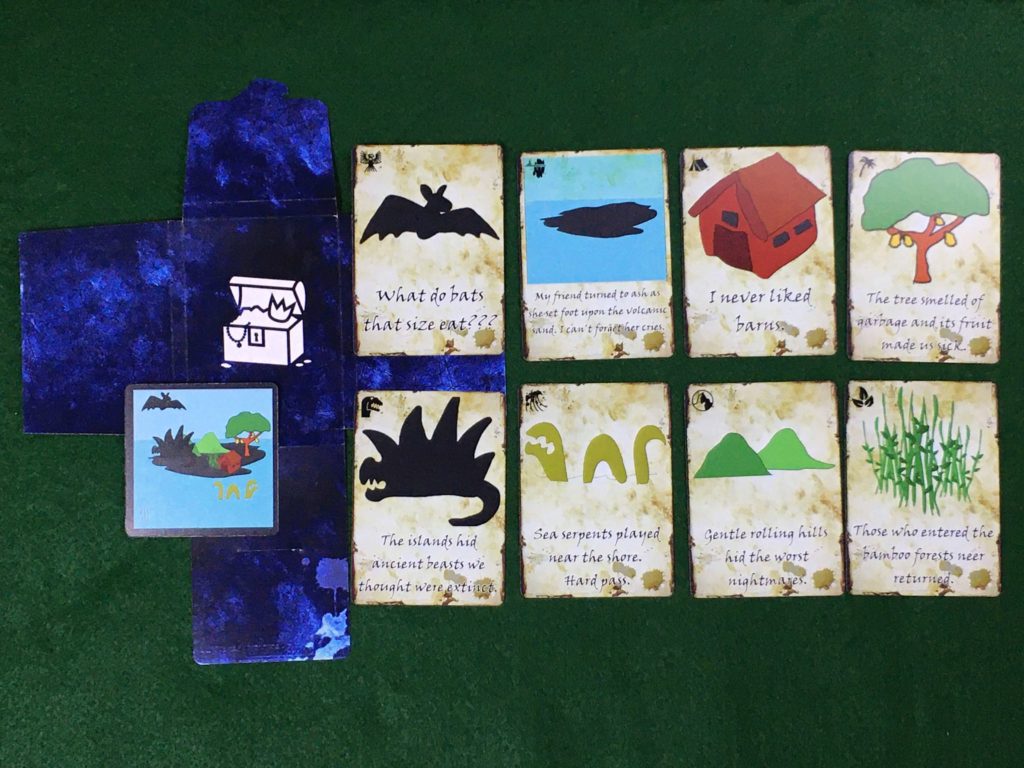
The back of the deduction sheets have a list of the actions available to you on your turn. Personally, the thing I found most difficult to understand and remember in this game were my win conditions vs the win conditions for the opposite team. Based on this, I would prefer to have the win conditions listed on the back of this card instead of the full explanation of the turn options. However, if both the turn options and win conditions were boiled down to bullet points so that they could both fit here, that could be nice, too.
Players use the dry erase pens to both record the island features they’ve seen on the deduction chart and to enter their choices on vote cards for the island number they want to guess as the solution or the name of a suspected Ravager.
The dry erase markers worked great for all of their uses in this game, staying in place when needed and rubbing off when needed.
Some play testers mentioned that the larger black blobby monsters were hard to mark off on their deduction sheet because they were the same color as the ink and there wasn’t enough blank space around the item in the checkbox.
The role cards had a slight misprint as compared to the list of components in the rule book in that there was only one Ravager role card while the setup instructions said to put 2 Ravagers in play no matter the player count.
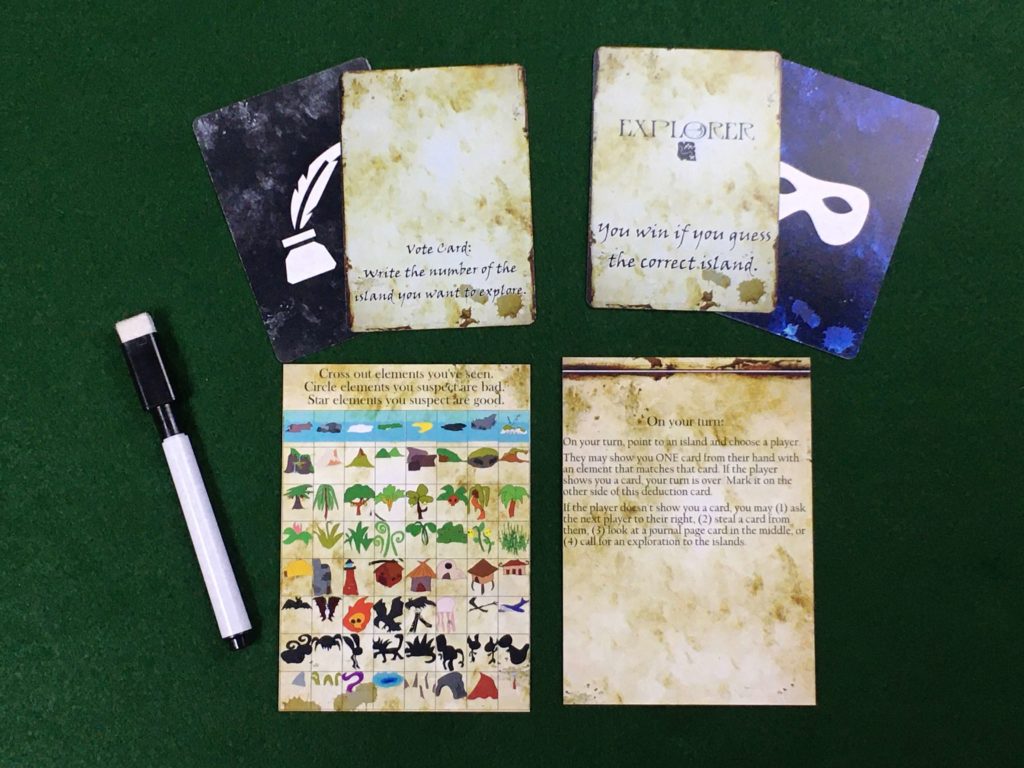
One suggestion for fixing the issue of having 16,777,152 sets of 8 captain’s journal cards without a matching island card was to only use cards from 2 categories of features to fill the treasure chest and distribute people’s hands. This would mean only 14 captain’s journal cards in play instead of 56 as in the original rules.
Unfortunately, based on the way the elements are currently mixed on the island cards, this also doesn’t solve the problem. There would still be several possible treasure chest combos that don’t have a solution shown on an island card — as well as several combos that would make for multiple safe islands.
For example, the grid of cards below is sorted into rows by landscape and columns by objects in the water. In the fifth row down, you can see that the combination of flying whale and flat tan landscape never shows up while the thin bird mixed with this landscape would represent 2 safe islands.
You can also see that the card four rows down on the far right and the card in the bottom right corner have several features in common (giant rabbit, lighthouse, flaming skull, tentacle, tree, and plant). This will mean that, with each of these individual features showing up on only 8 islands, there are several other features matched with these that will never show up together on an island.
So, although this adjustment makes it significantly less likely that there will be no island card representing the solution inside the treasure chest, it’s still far from unlikely.
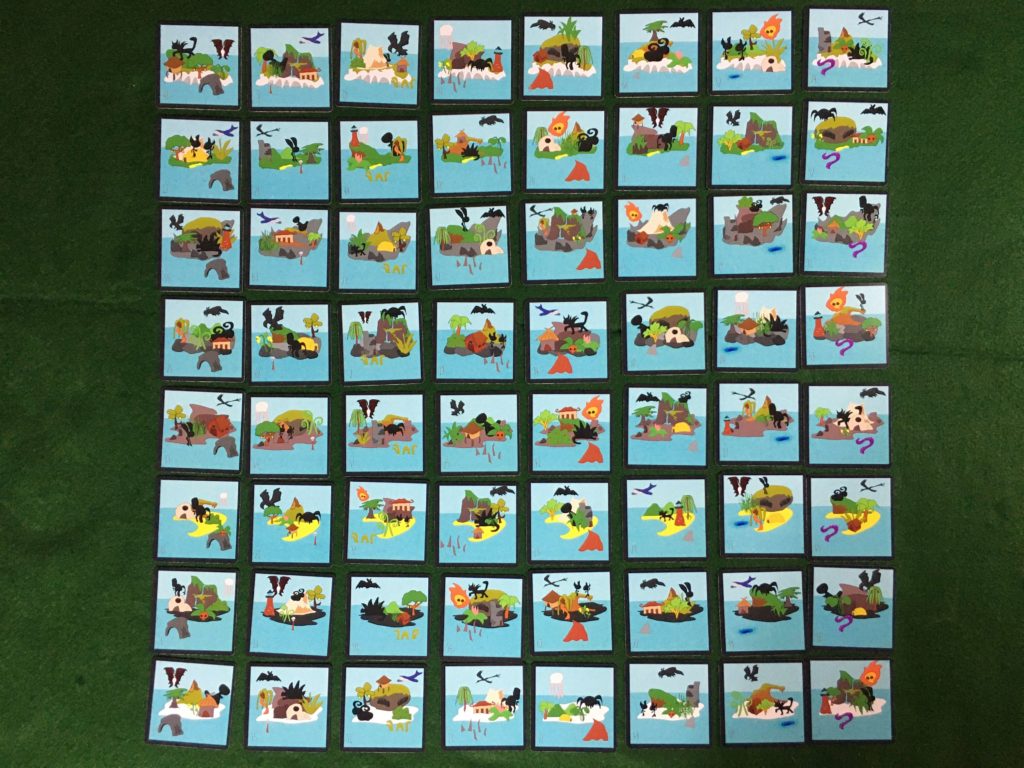
Because I am lucky enough to have a husband who has a math PhD, as he helped me wrap my head around what went wrong with the island cards, he came up with a working setup I think is worth sharing.
If there were 3 categories of 8 features, there would be a total of 512 (8^3) unique combinations of features. Since this is still far too many island cards to affordably fit in a game, the setup could use only 2 categories each time — again making for only 14 captain’s journal cards divided among the players each game.
The crucial element to making this work is combining the features on the island cards so that each individual feature from one category combines with each individual feature from the other 2 categories exactly once. The sketch below shows how 3 different types of features could be combined on the cards to make this happen.
I think it could be fun to keep all 8 different types of features on the island cards to make them a little more confusing and visually interesting, but these extra features wouldn’t need to be on the captain’s journal cards or deduction sheet.
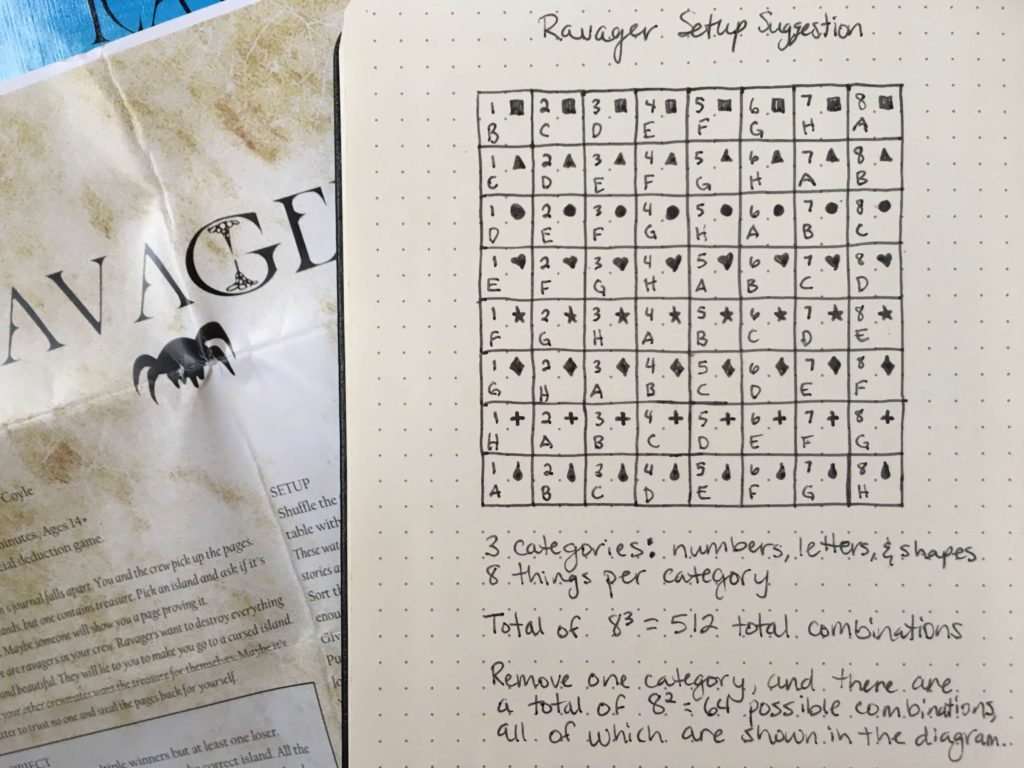
Another option for resolving this issue would be to keep the island cards the same and number the captain’s journal cards. Then, add a lists of captain’s journal card sets that match with included island cards. The numbers would have to be on the backs of the cards, hard to read from a distance, and not easy to memorize. The setup for this approach might be a bit cumbersome and fragile, but it would allow all the players to have more cards in their hands than the setup using only 3 categories.
Overall, the components themselves were good quality and had a lot of fun and creative things mixed in. This feels like a good start to something if the card combination issue can get sorted out.
Game Play and Mechanics
It’s a bit difficult for me to write a review of the game play for this one. Getting to the end of the game and finding that the solution wasn’t among the island cards was frustrating, but realizing there was only a 1 in 262,144 that we could have had a viable island was dumbfounding.
The effect was so dramatic that we all initially felt we had been the victims of an elaborate prank. Some players thought it was funny while others were angry.
However, now that I know the designer’s intention is definitely to have an island card available for every possible captain’s journal combination, I can share my impression of the the intended game play based on my experience before realizing the fatal flaw.
The procedure on each person’s turn is simple: point to an island and choose another player to ask if they have any evidence that it’s dangerous. This part is exactly like Clue minus the roll and move aspect.
Unlike Clue, though, if your target player doesn’t show you a card, you have the option to either peek at an unassigned card or ask the next player in clockwise order if they have evidence that the island is dangerous. If they also can’t or won’t show evidence of danger, you can keep asking all the way around the table until someone shows you something. This is a nice twist because it gets the information flowing quickly.
The most confusing part of the game was the option to call for a vote. To the best of my understanding, when you call for a vote, each player is at liberty to decide whether they want to write down the number of the island they think is safe or the name of someone they think is a Ravager. This felt a bit disorganized to me and left me feeling unsure of exactly what experience the designer was looking to create here.
The win conditions for both sides were a bit more convoluted than I would have liked them to be. It felt like I needed a flow chart to determine who would win and lose after certain voting outcomes.
I don’t usually gravitate to games with a timer, but I thought this game used the timer to good effect. It created a sense of urgency that felt thematic and kept everyone engaged.
The instructions recommend playing the game several times in a row and giving the winner or winners of each game a gold doubloon. The jury is out for me on whether or not I would be likely to want to play this game more than once in a row. I think I would have to see how the card combination issue is addressed and how that in turn affects the strategy for both the Explorer and Ravager teams.
Scoring
The following scoring breakdown is based on a rubric I released during the game design challenge on TGC’s contest page. All sections are worth a maximum of 1 point.
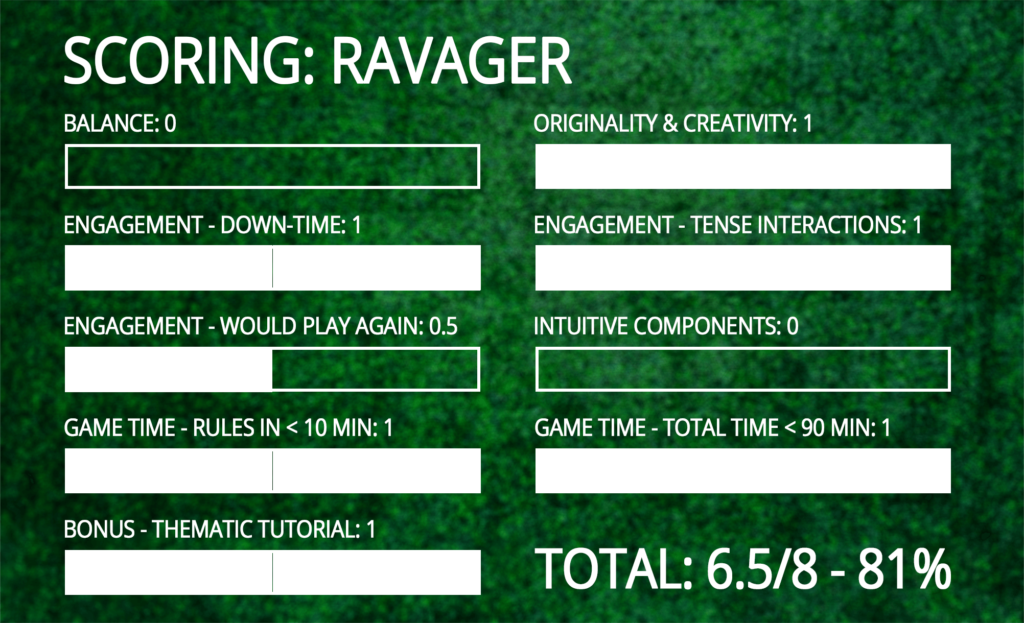
Balance: 0
As described at length above, the Explorer team’s main goal is highly likely to be unachievable, which makes for a pretty blatant disadvantage for one side.
Originality & Creativity: 1
While the deduction puzzle setup and execution in this game feels familiar, the mixture of logical deduction, traitors in the mix, a treasure map, and everything happening under the pressure of a 15 minute timer all worked together to make this game feel unique.
Engagement – Down-Time: 1
Working under the pressure of a timer made down time impossible during the game. I never felt like I was waiting around for my turn.
Engagement – Tense Interactions: 1
One interesting side effect of working to solve a puzzle with no solution as an Explorer was that it forced our hand to try and win by rooting out the Ravager instead. During the first few minutes of the game we were basically playing pirate-themed speed Clue. But, once it became clear we would never find the island in time, the accusations started flying.
Engagement – Would Play Again: 0.5
Since the Explorers are likely to have a futile search for the safe island, I would not want to play the version of this game that was entered in the contest again. However, I would be interested to play a future iteration.
I know the designer discovered the issue with the island cards on his own after the contest submission period closed and has already revised the rules at least once. I’m curious to see the final solution he settles on.
Intuitive Components: 0
Although the components in this game had a lot of positive things about them with nice thematic graphic design and several premium pieces, the over 16 million unrepresented possible solutions completely broke the game. I can’t give points for components that don’t support the game experience the rules claim they do.
Game Time – Rules in under 10 min: 1
It was easy for me to explain the basics of playing the game, and our group was able to get started quickly.
Game Time – Total Time under 90 min: 1
The 15 minute game timer made this play through guaranteed to take less than 90 minutes.
Although the lack of a correct solution among the island cards would have easily caused us to go over the time limit without the timer, the fact remains that the timer saved us from that fate.
Bonus – Thematic Tutorial: 1
The rules for this game had an italicized story interwoven with the setup and game play instructions. It was a bit difficult for me to pull off reading the story while I was teaching the group how to play. It may have been easier to implement as a story-driven tutorial if it was a separate script from the rule book, but it still managed to add fun and interest to the process of learning and teaching the rules.
Total Score: 6.5/8 – 81%
You can see the scoring breakdown for all the semi-finalists and finalists in this game design challenge in my public scoring spreadsheet.
Credits
Thank You to my Protospiel Madison Play Test Crew
Maxine Ekl, Deirdrea Lyon, Patrick McNeil, Ben Moy, and Will Newton
Leave a Reply